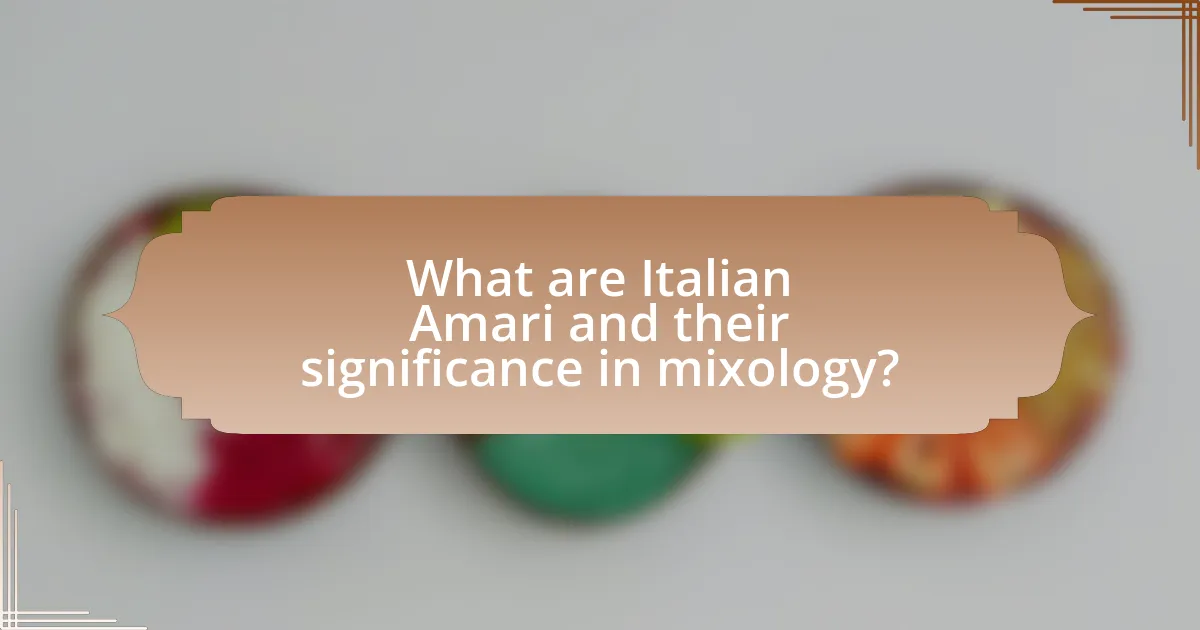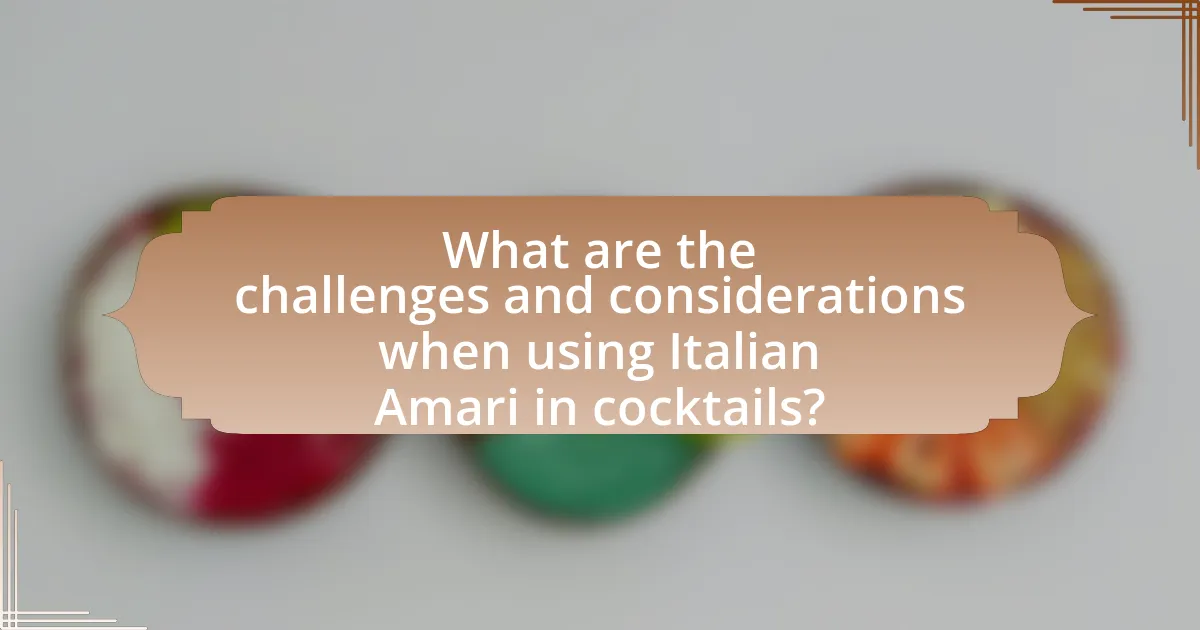Italian Amari are herbal liqueurs known for their complex flavors, traditionally consumed as digestifs, and play a significant role in contemporary mixology. This article explores the definition, categorization, and key ingredients of Amari, highlighting their diverse flavor profiles and the cultural factors contributing to their rising popularity in cocktails. It examines how bartenders incorporate Amari into classic and innovative cocktails, the techniques used to balance their bitterness, and the challenges faced in mixology. Additionally, it provides insights into effective customer education about Amari and offers tips for experimenting with these versatile liqueurs to create unique cocktails.

What are Italian Amari and their significance in mixology?
Italian Amari are herbal liqueurs that are traditionally consumed as digestifs, characterized by their complex flavors derived from a blend of herbs, spices, and botanicals. In mixology, Italian Amari play a significant role by adding depth and complexity to cocktails, enhancing flavor profiles and providing a balance of sweetness and bitterness. Their versatility allows bartenders to create innovative drinks, as evidenced by the popularity of cocktails like the Negroni and the Paper Plane, which prominently feature Amari. The historical significance of Amari dates back to the 19th century, with brands like Fernet-Branca and Aperol becoming staples in both Italian culture and global cocktail scenes, thus solidifying their importance in contemporary mixology.
How are Italian Amari defined and categorized?
Italian Amari are defined as herbal liqueurs that are typically bitter and are consumed as digestifs. They are categorized based on their flavor profiles, ingredients, and production methods, which can include classifications such as aromatic, bitter, sweet, and herbal. For instance, some well-known categories include Amaro Nonino, which is characterized by its complex herbal blend, and Fernet, known for its intense bitterness and medicinal qualities. The categorization is further supported by the Italian law that regulates the production of Amari, requiring a minimum of 30% alcohol by volume and the use of natural ingredients, which reinforces their identity within the broader category of liqueurs.
What are the key ingredients that make up Italian Amari?
The key ingredients that make up Italian Amari include a base spirit, typically neutral grain alcohol or a distilled spirit, and a blend of various botanicals, herbs, spices, and sometimes fruits. These botanicals can include ingredients like gentian, rhubarb, orange peel, and various aromatic herbs, which contribute to the complex flavor profile of Amari. The infusion process allows the flavors to meld, resulting in a bitter-sweet liqueur that is often enjoyed as a digestif. The specific combination of these ingredients varies by brand and recipe, leading to a wide range of flavor experiences within the category of Amari.
How do the flavor profiles of different Amari vary?
The flavor profiles of different Amari vary significantly based on their ingredients and regional production methods. For instance, Amaro Averna is characterized by a sweet, herbal profile with notes of citrus and caramel, while Fernet-Branca offers a more intense, bitter flavor with strong menthol and herbal undertones. Additionally, Amaro Montenegro presents a balanced sweetness with floral and orange zest notes, contrasting with the more bitter and complex profile of Amaro Nonino, which includes hints of spices and dried fruits. These variations arise from the unique blend of herbs, spices, and botanicals used in each Amaro, reflecting the local traditions and tastes of their respective regions in Italy.
Why have Italian Amari gained popularity in contemporary cocktails?
Italian Amari have gained popularity in contemporary cocktails due to their complex flavors and versatility in mixology. These herbal liqueurs, traditionally consumed as digestifs, offer a unique balance of bitterness and sweetness, enhancing the overall taste profile of cocktails. The rise of craft cocktail culture has led bartenders to explore diverse ingredients, and Amari’s rich botanical compositions provide depth and character to drinks. Additionally, the increasing consumer interest in artisanal and locally sourced products has further fueled the demand for Amari, as many brands emphasize traditional production methods and regional ingredients.
What cultural factors contribute to the rise of Amari in mixology?
The rise of Amari in mixology is significantly influenced by the growing interest in craft cocktails and the appreciation for complex flavors. This trend is driven by a cultural shift towards artisanal and locally sourced ingredients, as consumers increasingly seek unique and authentic drinking experiences. Additionally, the resurgence of Italian dining culture and the popularity of aperitivo rituals have further popularized Amari, as they are traditionally consumed as digestifs in Italy. The increasing visibility of Italian cuisine and lifestyle in global gastronomy has led to a broader acceptance and incorporation of Amari in cocktail menus, reflecting a desire for sophisticated and nuanced beverages.
How do Amari enhance the complexity of cocktails?
Amari enhance the complexity of cocktails by introducing a diverse range of flavors, aromas, and textures that elevate the overall drinking experience. These Italian herbal liqueurs are characterized by their bitter, sweet, and aromatic profiles, which can balance and complement other ingredients in a cocktail. For instance, the use of Amaro Nonino, with its notes of herbs and spices, can add depth to a Negroni, transforming it into a more nuanced drink. Additionally, the bitterness from Amari can counteract sweetness, creating a more harmonious flavor profile. This complexity is supported by the fact that there are over 100 different types of Amari, each with unique botanical blends, allowing mixologists to craft cocktails that are both innovative and layered in taste.

How are Italian Amari used in contemporary mixology?
Italian Amari are used in contemporary mixology primarily as complex flavoring agents in cocktails. These herbal liqueurs, characterized by their bittersweet profiles, enhance drinks by adding depth and balance. For instance, bartenders often incorporate Amari like Fernet-Branca or Aperol in classic cocktails such as the Negroni or Spritz, leveraging their unique botanical flavors to create a more nuanced drinking experience. The increasing popularity of Amari in craft cocktails is supported by the rise of the bitter flavor trend, which has been documented in various cocktail culture studies, highlighting a shift towards more sophisticated and layered taste profiles in modern beverages.
What are the most popular cocktails featuring Italian Amari?
The most popular cocktails featuring Italian Amari include the Negroni, the Americano, and the Paper Plane. The Negroni is a classic cocktail made with equal parts gin, sweet vermouth, and Campari, an Italian Amaro, which provides a bitter and aromatic profile. The Americano combines Campari and sweet vermouth topped with soda water, offering a refreshing drink with a lower alcohol content. The Paper Plane features equal parts bourbon, Aperol, Amaro Nonino, and lemon juice, showcasing the versatility of Amari in modern cocktails. These cocktails highlight the unique flavors of Italian Amari, which have become essential in contemporary mixology.
How do bartenders incorporate Amari into classic cocktail recipes?
Bartenders incorporate Amari into classic cocktail recipes by using it as a bittering agent or flavor enhancer, often substituting it for traditional bitters or vermouth. For example, in a Negroni, bartenders may replace sweet vermouth with an Amaro to add complexity and depth, as Amari typically have herbal and citrus notes that complement the gin and Campari. This practice is supported by the growing trend of craft cocktails, where the unique flavor profiles of various Amari are leveraged to create innovative variations of classic drinks, enhancing both taste and presentation.
What innovative cocktails have emerged using Amari?
Innovative cocktails using Amari include the “Negroni Sbagliato,” which substitutes prosecco for gin, and the “Amaro Sour,” combining Amari with citrus and egg white for a frothy texture. These cocktails highlight Amari’s versatility, as they incorporate its complex herbal flavors into modern mixology. The Negroni Sbagliato gained popularity in the 2010s, showcasing Amari’s ability to adapt to contemporary tastes, while the Amaro Sour reflects a trend towards using Amari in classic cocktail formats, enhancing their depth and richness.
What techniques are used to mix cocktails with Amari?
Techniques used to mix cocktails with Amari include layering, stirring, and shaking. Layering involves carefully pouring Amari over other ingredients to create distinct layers, enhancing visual appeal and flavor complexity. Stirring is commonly used to combine Amari with spirits and mixers, ensuring a balanced dilution and temperature without aeration. Shaking is employed when Amari is mixed with citrus juices or other ingredients that require thorough integration, resulting in a frothy texture and vibrant flavor. These techniques leverage the unique bitter and herbal profiles of Amari, contributing to the overall character of the cocktail.
How does the choice of Amari affect the overall cocktail experience?
The choice of Amari significantly influences the overall cocktail experience by adding complexity, depth, and unique flavor profiles. Amari, which are Italian herbal liqueurs, vary widely in bitterness, sweetness, and aromatic characteristics, allowing bartenders to craft cocktails that cater to diverse palates. For instance, using a bitter Amaro like Fernet-Branca can create a more robust and intense drink, while a sweeter option like Amaro Nonino can enhance the cocktail’s smoothness and balance. This versatility not only enriches the flavor but also impacts the cocktail’s aroma and visual appeal, making the choice of Amari a crucial element in mixology.
What garnishes and mixers pair well with Amari-based cocktails?
Garnishes and mixers that pair well with Amari-based cocktails include citrus fruits, herbs, and tonic water. Citrus fruits like orange, lemon, and grapefruit enhance the bitter and herbal notes of Amari, while fresh herbs such as mint and basil add aromatic complexity. Tonic water serves as an excellent mixer, balancing the bitterness with its sweetness and effervescence. These combinations are widely recognized in cocktail culture, as they complement the unique flavor profiles of various Amari, making them more palatable and enjoyable.

What are the challenges and considerations when using Italian Amari in cocktails?
Using Italian Amari in cocktails presents challenges such as balancing their complex flavors, managing their bitterness, and understanding their diverse profiles. The complexity of Amari, which can range from herbal to citrusy, requires careful consideration to ensure they complement rather than overpower other ingredients. Additionally, the inherent bitterness of Amari can dominate a cocktail if not balanced with sweet or acidic components. For instance, a classic Negroni utilizes equal parts of gin, sweet vermouth, and Campari, showcasing how the bitterness of Amari can be effectively integrated. Understanding the specific flavor notes of each Amaro is crucial, as they can vary significantly; for example, Fernet-Branca is much more intense and bitter compared to Aperol, which is lighter and sweeter. Therefore, mixologists must experiment and adjust ratios to achieve a harmonious blend, ensuring that the unique characteristics of Italian Amari enhance the overall cocktail experience.
How do bartenders balance the bitterness of Amari in cocktails?
Bartenders balance the bitterness of Amari in cocktails by incorporating complementary flavors such as sweetness, acidity, and herbal notes. For instance, they often use ingredients like simple syrup, citrus juices, or sweet vermouth to counteract the bitterness, creating a more harmonious flavor profile. This technique is supported by the principle of flavor balancing, where contrasting tastes enhance the overall drinking experience. Additionally, the use of bittersweet ingredients, such as Aperol or Campari, can further integrate the Amari into the cocktail while maintaining a balanced taste.
What common mistakes should be avoided when mixing with Amari?
Common mistakes to avoid when mixing with Amari include using overly sweet mixers, neglecting to balance flavors, and failing to consider the Amari’s unique characteristics. Overly sweet mixers can overpower the complex herbal and bitter notes of Amari, leading to an unbalanced drink. Balancing flavors is crucial; for instance, pairing Amari with citrus or bitter ingredients can enhance its profile rather than masking it. Additionally, understanding the specific Amari being used is essential, as each has distinct flavor profiles and alcohol content that influence the overall mix.
How can bartenders effectively educate customers about Amari?
Bartenders can effectively educate customers about Amari by providing detailed tastings and engaging narratives about the origins and characteristics of each Amaro. By offering samples, bartenders can highlight the diverse flavor profiles and traditional uses of Amari in cocktails, enhancing customer understanding and appreciation. For instance, sharing the historical context of Amari, such as their roots in Italian herbal medicine and their evolution into popular digestifs, can create a richer experience. Additionally, bartenders can utilize visual aids, such as menus that describe the ingredients and production methods of various Amari, to further inform customers. This approach not only fosters a deeper connection to the drink but also encourages informed choices, ultimately enhancing the overall drinking experience.
What tips can enhance the use of Italian Amari in mixology?
To enhance the use of Italian Amari in mixology, bartenders should focus on balancing flavors, utilizing Amari as a bittering agent, and experimenting with various mixers. Balancing flavors is crucial; Amari’s complex profiles can complement sweet, sour, and savory ingredients, creating well-rounded cocktails. For instance, using Amari in place of traditional bitters can add depth to classic cocktails like the Negroni or Manhattan. Additionally, experimenting with mixers such as tonic water, soda, or citrus juices can highlight the herbal and botanical notes of Amari, making them versatile in both stirred and shaken drinks. This approach aligns with the growing trend of craft cocktails that emphasize unique flavor combinations and artisanal ingredients.
How can one experiment with Amari to create unique cocktails?
To experiment with Amari and create unique cocktails, one can start by mixing different types of Amari with various spirits, bitters, and fresh ingredients. For example, combining a herbal Amaro like Fernet-Branca with gin and citrus can yield a refreshing and complex drink. Additionally, using Amari as a modifier in classic cocktails, such as substituting sweet vermouth with an Amaro like Averna in a Negroni, can introduce new flavor profiles. The versatility of Amari, which often contains a blend of herbs, spices, and botanicals, allows for creative combinations that enhance the overall taste experience.
What resources are available for learning more about Amari in cocktails?
Books, online courses, and industry publications are valuable resources for learning about Amari in cocktails. Notable books include “Amaro: The Spirited World of Bittersweet, Herbal Liqueurs” by Brad Thomas Parsons, which provides in-depth knowledge about various Amari and their uses in cocktails. Online platforms like MasterClass offer courses on mixology that often cover Amari, while industry publications such as “Imbibe” and “Liquor.com” frequently feature articles and recipes highlighting Amari’s role in contemporary cocktails. These resources collectively enhance understanding and practical application of Amari in mixology.










